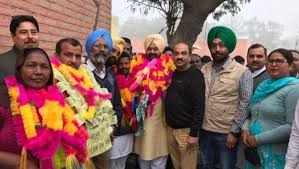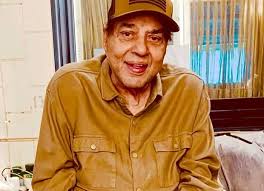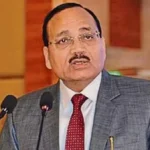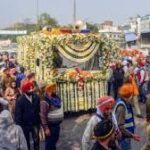Listen To This Post
For India, Dharmendra was a star. For Punjab, he was Dharam Bha Jee.
Written by: HARISH MANAV / Thenewsdose.com
Veteran Bollywood icon Dharmendra, one of Hindi cinema’s most adored stars and a legend whose charisma transcended generations, passed away on Monday morning in Mumbai at the age of 89. Police sources at the cremation ground confirmed that the actor, who had been ailing for nearly a month, breathed his last before dawn. His final rites were performed at the Pawan Hans crematorium. Dharmendra would have turned 90 on December 8.
His death has plunged not just the Indian film fraternity into mourning, but also his native village Dangon in Ludhiana district, where preparations were quietly underway to mark his milestone 90th birthday with Punjabi warmth and affection — including a special meal of sarson da saag, makki di roti, and even a symbolic two-wheeler ‘jugaad rehri’ that the villagers hoped he would ride once again.
A Village’s Unfulfilled Wish for Its Hero
In Dangon, where Dharmendra’s journey began and where he remained deeply rooted emotionally, villagers had been planning a heartfelt celebration. Social activist Kulwinder Singh Dangon, who had shared a personal bond with the actor for more than a decade, said that villagers had been praying for Dharmendra’s recovery in recent weeks and were eagerly awaiting his landmark birthday.
They remembered his fond desire: to sit beside a traditional earthen oven (chulah), relishing freshly prepared makki di roti and sarson da saag, and to ride a jugaad rehri like old times.
“Dharmendra ji told us during a meeting in Chandigarh years ago that he wished to enjoy saag and roti in the village style, sitting by the chulah, and ride a local-made rehri again,” said Kulwinder. “We were preparing to fulfil this on his 90th birthday. God had other plans.”
Villagers had even selected the mustard foliage to be plucked from fields now cultivated by the families of Shingara Singh and Manjit Singh — Dharmendra’s cousins — to whom he had gifted nearly two acres of his ancestral land in April 2015. The gift deed was signed personally by the actor during a function at Swami Ganga Giri Girls College, Raikot.
Despite age and failing health, Dharmendra remained emotionally invested in Dangon. Locals fondly recalled how he would often visit incognito because of the massive crowds he drew. His humility, they said, was legendary.
“Whenever we thanked him for bringing honour to the village, he always said his success was due to the blessings of the people here,” recalled cousin Manjit Singh.
A Stardom That Never Dimmed Across Eras
An outsider from rural Punjab who conquered Hindi cinema, Dharmendra acted in over 300 films, becoming one of Bollywood’s most enduring superstars. Remarkably, his stardom remained intact even during the eras dominated by Rajesh Khanna and Amitabh Bachchan — a rare phenomenon in an industry known for rapid turnover.
His filmography is a treasure trove:
-
the iconic Veeru in Sholay,
-
the sensitive soldier in Satyakam,
-
the charming professor in Chupke Chupke,
-
action milestones like Phool Aur Patthar,
-
And the popular entertainers of the 1970s, including Yaadon Ki Baraat, Seeta Aur Geeta, Pratigya, Dream Girl, and Dharam Veer.
He was affectionately known as Bollywood’s “He-Man”, yet his range extended far beyond muscular roles to poignant dramas and lighthearted comedies.
In recent years, he made notable appearances in films like Life in a… Metro, Apne, Yamla Pagla Deewana, Rocky Aur Rani Kii Prem Kahaani and Teri Baaton Mein Aisa Uljha Jiya. His next film, Ikkis, featuring Agastya Nanda, is slated for a December release.
The Early Life: From Sahnewal to Stardom
Born Dharmendra Singh Deol in 1935 in Sahnewal near Ludhiana, the son of a schoolteacher, his dreams of cinema began in a small Punjab village far removed from Bombay’s studios. His break came after he won a talent contest organised by a film magazine, leading to his Bollywood debut with Dil Bhi Tera Hum Bhi Tere (1960).
His career took off with Shola Aur Shabnam (1961), followed by acclaimed performances in Anpadh (1962) and Bimal Roy’s Bandini (1963). His screen presence, good looks, and versatility quickly made him a national favourite.
Family, Films, and the Man Behind the Star
Dharmendra’s personal life was often in the public gaze. While married to his first wife,, Prakash Kaur, he later married actor Hema Malini, yet remained closely connected to his first family, maintaining what the industry often called a “delicate but dignified balance.”
He established Vijayta Films in 1983, launching his son Sunny Deol with the hit Betaab. The banner went on to produce notable films like Ghayal (which won a National Award), Barsaat, Socha Na Tha, and Pal Pal Dil Ke Paas, which introduced his grandson Karan Deol.
In 2012, he was honoured with the Padma Bhushan.
His political stint — representing Bikaner in the Lok Sabha from 2004 to 2009 — was brief. After leaving politics, he devoted himself entirely to cinema and family life.
Final Years and Farewell
Dharmendra had been hospitalised in October for breathlessness and eye-related complications, including a recent corneal transplant. Although his team had said he was recovering well, his health continued to decline over the past month.
He leaves behind a large, close-knit family — sons Sunny and Bobby, daughters Ajeeta, Vijayta, Esha, and Ahana, and wives Prakash Kaur and Hema Malini.
A Legend Lives On
As Bollywood mourns, so does Punjab — especially little Dangon, where villagers today grapple with the heartbreak of unfulfilled plans: the sarson da saag that will no longer be sent, the jugaad rehri that will remain parked, and the earthen chulah beside which their beloved “Dharam Paaji” had hoped to sit once again. For India, Dharmendra was a star. For Dangon, he was family.














